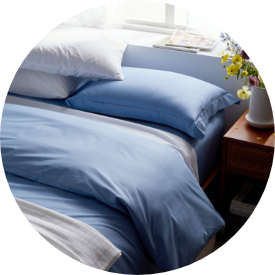



How to Sleep Better:
Dr. Darria’s Top 5 Tips
Did you know that solving your sleep problems could be as easy as a simple sleep-space fix? Yep. For all
the
time we spend worrying about getting enough ZZZZs, sometimes we don’t realize how much our sleep
environment
can impact both our ability to fall asleep and our quality of sleep—and how easy it can be to improve
both.
How can that be? It’s all biology: our body clocks sync with our environment; when our environment feels
restful, it signals our brain that it’s time (and safe!) to fall asleep. But even a subtly non-restful
environment sends unconscious signals to stay awake—stealthily robbing us of our ZZZZs.
So, if you’re struggling to snooze and want to know how to sleep better, it’s time for my “Sleep Space
Audit.” Use these five science-based steps to turn your bedroom into a sleep-promoting sanctuary.


1
Set the Perfect Sleeping Temperature
The thermostat war stakes are real: temperature is a major driver of sleep. While our bodies average 98.6 F, our temperature actually fluctuates. It dips a little during the afternoon, rises again, and then falls back down around 10 p.m. That temperature fall signals your brain to sleep (which is why the temporary afternoon dip makes you want to take a nap), but here’s the amazing thing: you can actually hack it at night to make sleep easier.
Anything that facilitates or mimics your body’s natural nighttime drop in temperature will help you sleep. Try:
- Keeping the room between 63 to 68 F, the optimal sleeping temperature range
- Running a fan in the room to facilitate air circulation (and body cooling)—and, as a bonus, white noise can be good for sleep
- Taking a warm shower right before bed—your body temperature will drop as soon as you step out of the shower, signaling to your brain that it’s time to sleep
- Choosing bedding pieces that help regulate your body temperature, like a cooling gel mattress topper or pad
2
Turn the Lights Down Low to Improve Sleep Quality
Light is the NUMBER ONE driver of our internal body clock. In fact, the part of the brain that releases
melatonin, the sleep hormone, has cells that recognize light and dark. Even just moderately bright
lights
turn off melatonin production, while dark causes the release of melatonin.
I suggest that in the hour before bedtime, everyone only use bedside lamps that are 30 watts or
fewer—not
bright white LED or overhead lights. For example, the new “sleep bulbs” that are a faint yellow or
cream,
rather than bright blue-white. Studies have shown that bright light can suppress melatonin levels for 60
to
90 minutes, making it more difficult to fall asleep.
Lastly, do a light audit: when it’s dark, turn off the lights in your room, wait a minute or two for
your
eyes to adjust, and then look around—what lights do you see? Chances are, you’ll see the blinking from a
cable box, thermostat, alarm, phone charger…all of which add up—and can be perceived by your brain even
with
your eyes closed! Eliminate those little sleep robbers by moving or covering them.


3
Choose the Right Bedding to Promote Sleep
Ever had that feeling—whether it was at a hotel, spa, or someone’s home—where you got into bed and just
seemed to settle into soft, cozy, deliciousness? THAT is how you want your bed to feel—calming colors,
soft
sheets, comforting bedding that’s just the right weight.
If your current sheets feel as soft as your childhood summer camp cot, it’s time to make a switch.
(Trust
me. I did this recently—you will NEVER go back). Aim for sheets that are breathable, like natural
percale
cotton sheets between 300 to 500 thread count. This is a great chance to make sure you’re using the
right
blankets and comforters, too. If you tend to get hot at night, consider using a lighter blanket or a
very
lightweight comforter (which is light enough for summer use). If you sleep on the colder side, look for
heavier comforters to keep you toasty all winter long.
4
Cut the Bedroom Clutter
If you walk into your bedroom and see stacks of paperwork, piles of laundry, and a trove of unmatched
socks,
then your room is a living to-do list—the moment you walk into that space, your brain thinks of
everything
EXCEPT sleep. Your bedroom should be a peaceful sanctuary, so try to keep work and other clutter to a
minimum—get organized, and make your bedroom a sleep-only zone.
Choose bedding that adds calming, peaceful colors and patterns to really amp up the “sanctuary” vibe.
Changing out a duvet cover and matching pillowcases is also an easy way to instantly upgrade your
bedroom
look and feel to create a relaxing space.


5
Fluff That Pillow
If the last time you bought a pillow was when you used dial-up, then it’s time for a swap. Pillow technology (like, well, EVERYTHING) has come a long way—there’s a true pillow buffet available to you!
Consider these things when choosing a pillow:
- Pillow size: The most common options are standard, queen, and king.
- Fill type: Do you prefer down or down alternative?
- Density: Do you like a softer feel, or a firm pillow?
- Preferred sleep position: There are pillows designed for support for back, side, and stomach sleepers.
- Hypoallergenic: While our down and down alternative are hypoallergenic, a protective, allergy-proof cover can block dust, mites, and allergens.
If you find that you get back, arm, or other pain while you sleep, you can even consider the variety of
specialty support pillows designed to help you wake up truly refreshed.
Follow these five easy sleep tips and you’ll be smiling as you drift off to dreamland for some restoring ZZZZs.
Sweet
dreams and an energetic tomorrow!

About Dr. Darria Long, MD MBA
Dr. Darria Long is the nation’s go-to doctor for distilling the best information to make our lives healthier,
better, and easier. She is a Harvard and Yale-trained Emergency physician, international TV contributor and regular
on
CNN, Headline News, The Dr. Oz Show, NBC, and other outlets, national
bestselling author of Mom Hacks, and TedX speaker of the now
widely popular “An ER doctor on triaging your crazy busy life” - and mom of 2. She’s also the
founder of
the TrueveLab - your data-driven source of truth for all things health.
Dr. Darria is a Clinical Assistant Professor at the University of Tennessee and received her training in
emergency medicine at Yale School of Medicine and her MBA from Harvard Business School. Combining her life’s
work as an Emergency Room Physician, patient with autoimmune arthritis, and mother, Dr. Darria distills
complex
information for her audiences to give people holistic, evidence-based, and manageable solutions for their
health
and wellness.
